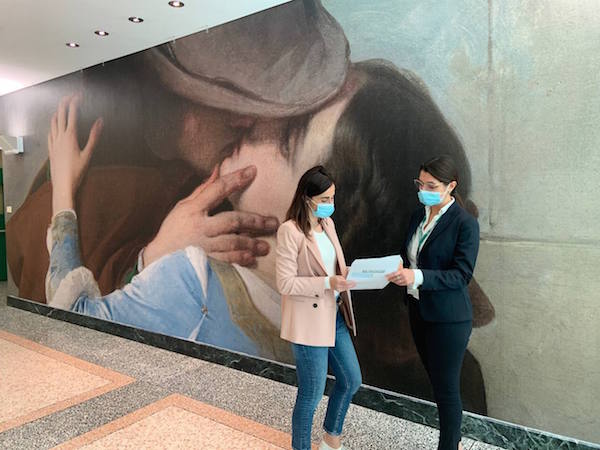“Brera in Humanitas”: Entrance, Francesco Hayez, The kiss (detail)
“It could be seen as a trivial thing, posting works of art on the walls of a hospital. Instead it is a commendable and innovative initiative”, he comments James Bradburne, director of the Brera Art Gallery: “If we think about it, we too at the museum deal with care with a human mediation. At the museum we have a figure, the ‘curator’, who deals with the conservation and enhancement of works of art. Our ‘curator’, in this specific case Alessandra Quarto (ndrrecently moved to the Poldi Pezzoli Museum with the position of director), who put the details of some works in the building of the Humanitas hospital”.
Thus, from now on patients awaiting hospitalization will sit in the garden of One after lunch together with the elegant guests of the Macchiaiolo Silvestro Lega, after being greeted at the entrance by the passionate tenderness of Kiss by Hayez. A 40 square meter vegetable garden full of pumpkins, guarded by the placid Greengrocer by Vincenzo Campi, will welcome those preparing for chemo, while the touch of the hands of Venetian lovers by Paris Bordon will instill confidence in the intended parents in the waiting room of the Fertility Center.
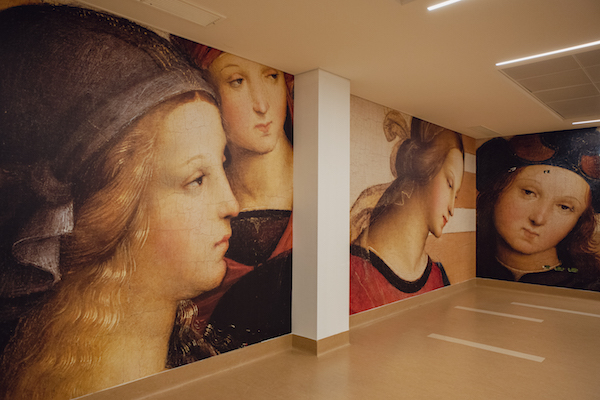
“Brera in Humanitas”: Radiology, Raphael, Marriage of the Virgin (detail)
“No hospital has visitors. We go to the hospital when we need to be treated and we put ourselves in the hands of someone who takes care of us”, continues Bradburne: “In general, we think of the museum as a place of amusement, of recreation. A museum should be there for the citizenry, for the community when it needs it: throughout life, from birth to death. But the museum must be there even when I can’t go: in fact, we have a welcome program for people with Parkinson’s, for example. In a nutshell, we ensure that the museum is no longer a noun, but a verb. An inclusive term for all community members when they feel they need to. This link between ‘care’ and ‘museum’ gave birth to this initiative. Just as a city is needed to be a citizen, so the museum lives where we are. Beauty has this effect of caring and being comfortable with fragility. Where better could the works of Brera be if not in a hospital? We need to have a holistic view of our role in society because we strongly believe in humanity.”
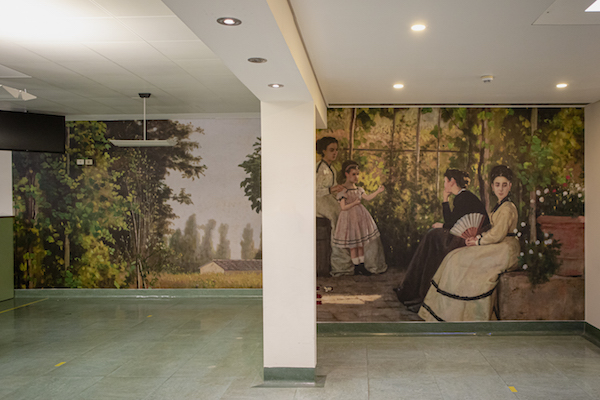
“Brera in Humanitas”: Admissions-Hospitalizations, Silvestro Lega, An After Lunch (detail)
Even Humanitas is not new to this kind of initiative. In 2018 the “Care and beauty” project brought the masterpieces of the Carrara Academy to the Humanitas Gavazzeni and Castelli hospitals in Bergamo and in spring 2020, in the midst of the pandemic, the installations accompanied doctors and nurses during the hard months of the struggle. Even today, intensive care patients find the View of the Grand Canal from Ca’ Foscari towards the Rialto Bridge by Canaletto, a reassuring vision, but also a push to imagine the future, perhaps starting with a trip to Venice.
“In recent years we have witnessed a technological revolution that has invested the medical sector. 50% of digital data in the world is produced by the medical sector, we are able to modify genetics, we can introduce new components into our body. Our approach has been to embrace innovation and technology while always keeping empathy strong,” she says the president of Humanitas Gianfelice Rocca, and continues: “Each of us ends up losing our roots when we enter a hospital. Our project was born with the idea of making the hospital an efficient and beautiful place. Art in this sense is fundamental. There will be an increasing need in the future for museums and hospitals to be nodes of thought and not mere cathedrals”.
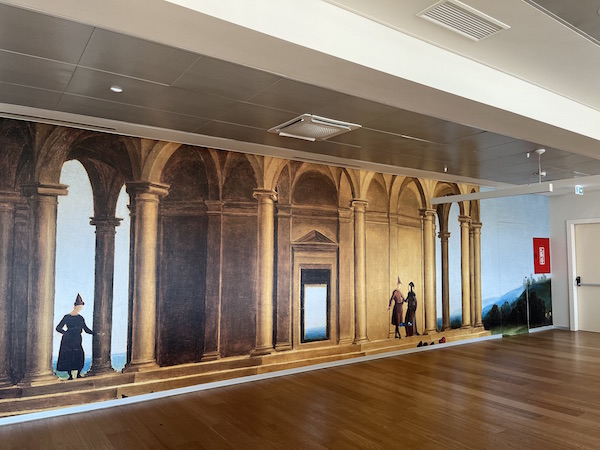
“Brera in Humanitas”: Check-up room, Raphael, Marriage of the Virgin (detail)
In Milan, the spirit is the same: the details selected for “Brera in Humanitas” evoke the parallel between art as a cure and care as art, in a hospital attended by 12,000 people every day. Furthermore, patients and staff of the Institute will have the privilege of admiring paintings that are not currently visible in the normal museum visit itinerary. To coordinate the choice of subjects was Alessandra Quarto, today at the helm of the Poldi Pezzoli Museumwho started the project in 2021, when he was deputy director of the Pinacoteca di Brera.
“The intention was to change the quality of waiting time and to make hospitality different, aware that the humanisation of care spaces causes the environment to have a positive impact on people,” he explains. “We took details of works of art, details of gestures, looks, landscapes and also details of works not exhibited in the museum. For example, in the corridor leading to the nurses’ changing rooms, which has no windows, we have placed two details from View of Gazzada, a Lombard landscape painted by Bernardo Bellotto to offer a new vision to those who pass by. In the radiology and check up area we have chosen a detail of the temple depicted by Raphael in the Marriage of the Virgin to offer a horizon beyond the walls and in the waiting room of the breast clinic the detail of the girl’s hands holding up the Flowerpot by Francesco Hayez”, a masterpiece from which grace and femininity breathe.
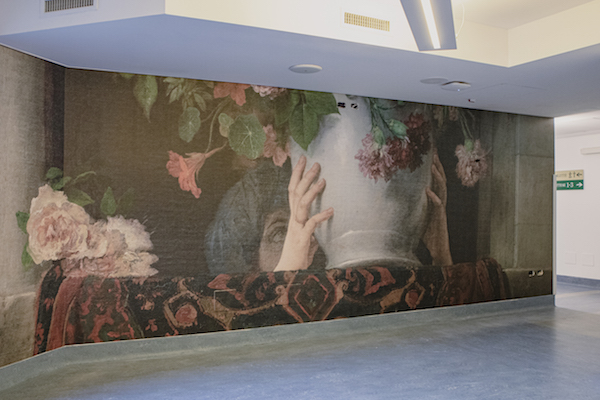
“Brera in Humanitas”: breast clinic, Francesco Hayez, Vase of Flowers (detail)
